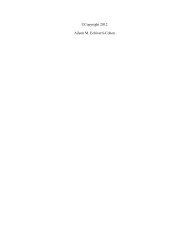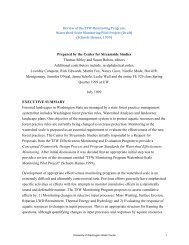c Copyright 2011 Katherine Nichole Deibel Understanding and ...
c Copyright 2011 Katherine Nichole Deibel Understanding and ...
c Copyright 2011 Katherine Nichole Deibel Understanding and ...
Create successful ePaper yourself
Turn your PDF publications into a flip-book with our unique Google optimized e-Paper software.
Reading Disabilities 15<br />
abilities will grow rusty <strong>and</strong> inefficient without regular practice. Simply put, a person needs the opportunity<br />
<strong>and</strong> encouragement to practice reading beyond the initial instruction.<br />
The definition used by Dickinson et al. (2002) fails to exclude another potential reason for poor reading<br />
performance: poor vision. Many definitions of reading disabilities also recommend ruling out any potential<br />
visual impairments before labeling a person as having an RD (Evans, 2001). Being blind or having low<br />
vision is a sensory disability, not a reading disability. 3 Additionally, vision problems like nearsightedness,<br />
farsightedness, <strong>and</strong> astigmatisms can hinder the reading process by inducing physical strain <strong>and</strong> exhaustion<br />
when reading. Evans, a professor of optometry, has experienced <strong>and</strong> commented about multiple cases of<br />
children struggling with reading showing marked improvement after receiving proper vision care (2001).<br />
1.1.2 Working Definition<br />
Reasonable alternatives are thus always ruled out before diagnosing a reading disability. Although it may<br />
seem unscientific to define RD as poor reading performance for reasons not identified, remember that reading<br />
disabilities are best thought of as a syndrome of related conditions. Moreover, reading itself is a complex<br />
process <strong>and</strong> problems can manifest at any point or points in that process. Diversity is to be expected. This is<br />
why after ruling out other possibilities, additional neuropsychological exams are then administered to better<br />
underst<strong>and</strong> the exact nature of the person’s reading disability (Edwards, 1994; Peer, 2001; Ashton, 2001).<br />
Thus, the definition of reading disability used in this dissertation reflects both ruling out alternatives <strong>and</strong> the<br />
inherent diversity possible:<br />
A reading disability is a syndrome of multiple conditions in which a person experiences difficulty<br />
with one or more aspects of the reading process despite possessing sufficient intelligence,<br />
learning, practice, <strong>and</strong> sensory capability.<br />
1.2 Related Terminology<br />
As shown in Figure 2.1, reading disabilities are a subset of several classes of disability. Although this<br />
dissertation focuses on RDs, these other classes occur frequently enough in the literature to warrant a brief<br />
coverage here. Working inward, this all begins with the concept of disability. As defined by the Americans<br />
with Disabilities Act (ADA) (1990) <strong>and</strong> the World Health Organization (Sears & Young, 2003), a disability is<br />
a physical or mental difference/impairment that negatively impacts one or more major life activities. 4<br />
One major subclass of disability is cognitive disabilities. Associated with the brain <strong>and</strong> its functioning,<br />
these disabilities affect aspects of learning, memory, emotions, thinking, sensory processing, socialization,<br />
<strong>and</strong> communication (American Psychiatric Association (APA), 2000; Dawe, 2006). They also range in degree<br />
of severity: mild, moderate, severe, <strong>and</strong> profound. Thus, a broad range of conditions are considered cognitive<br />
disabilities. Psychological conditions such as obsessive-compulsive disorder <strong>and</strong> depression are members of
















